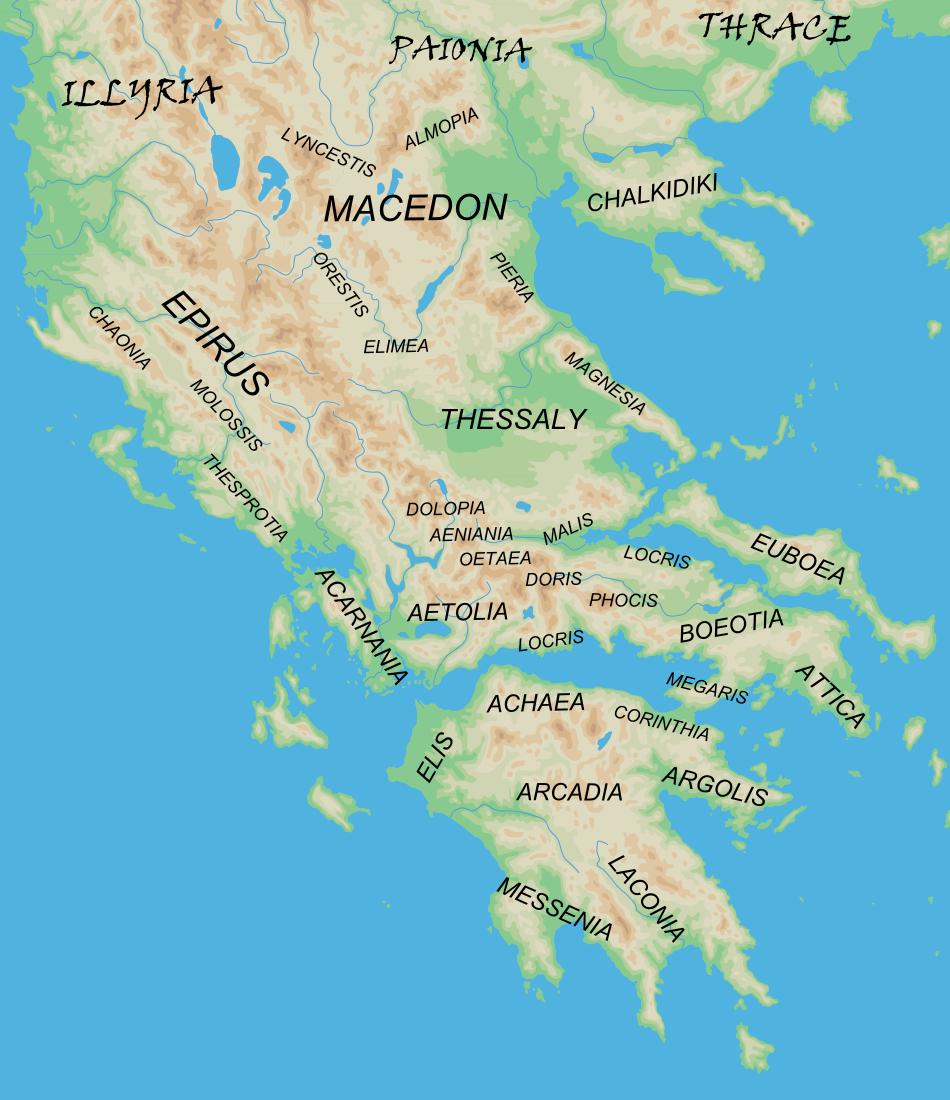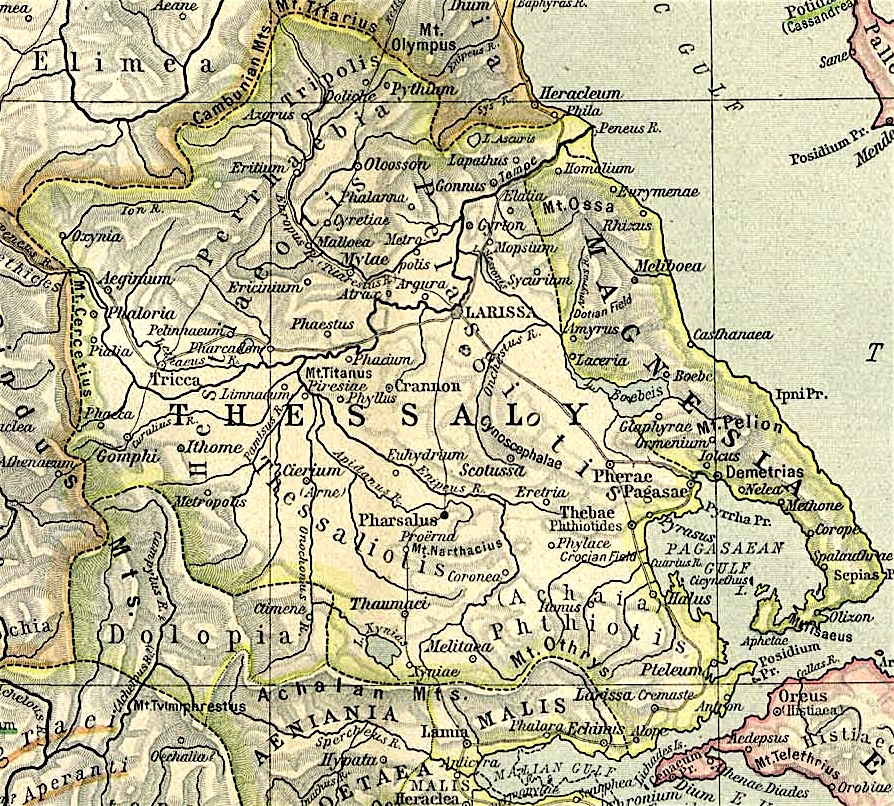|
Dolopia
Dolopia () is a mountainous region of Greece, located north of Aetolia. Geography Dolopia was located between Epirus and Thessaly, eventually absorbed into the latter. It was a mountainous district in the southwestern corner of Thessaly, lying between Mount Tymphrestus, a branch of Pindus, on the one side, and Mount Othrys on the other. The Dolopes were, like the Magnetes, an ancient Hellenic people, and members of the Amphictyonic League. They are mentioned by Homer as included in Phthia, but were governed by a subordinate chieftain of their own. Though nominally belonging to Thessaly, they seem practically to have been independent: and their country was at a later period a constant subject of contention between the Aetolians and the kings of Macedonia. The only place in Dolopia of the slightest importance was Ctimene. Other of their cities were, Angeia and Dolopeis, close to lake Xynius. Mythology and history The Dolopes () were considered Thessalians, or sometimes Ae ... [...More Info...] [...Related Items...] OR: [Wikipedia] [Google] [Baidu] |
Regions Of Ancient Greece
The regions of ancient Greece were sub-divisions of the Hellenic world as conceived by the ancient Greeks, shown by their presence in the works of ancient historians and geographers or in surviving legends and myths. Conceptually, there is no clear theme to the structure of these regions. Some, particularly in the Peloponnese, can be seen primarily as distinct geo-physical units, defined by physical boundaries such as mountain ranges and rivers. Conversely, the division of central Greece between Boeotia, Phocis, Doris and the three parts of Locris, seems to be attributable to ancient tribal divisions and not major geographical features. Both types of regions retained their identity throughout the Greek Dark Ages and its tumultuous changes in the local population and culture, giving them a less political and more symbolic presence. Other geographical divisions not identified with the aforementioned areas did, however, change over time, suggesting a closer connection with triba ... [...More Info...] [...Related Items...] OR: [Wikipedia] [Google] [Baidu] |
Ctimene (Thessaly)
Ctimene or Ktimene (), was a town and polis in ancient Thessaly, on the borders of Dolopia and Phthia, near the Lake Xynias. It is cited by Apollonius of Rhodes as the place of origin of one of the argonauts, Eurydamas, and relates it to the tribe of the Dolopes. Livy relates that the retreat of Philip V of Macedon after the Battle of the Aous (198 BC) allowed the Aetolians to occupy much of Thessaly, and these latter devastated the town called Cymene and its neighbour, Angeia. William Smith treats the reference to ''Cymene'' as a probable corruption of Ctimene. Stephanus of Byzantium mentions a tradition that Ctimene had been given by Peleus to Phoenix. The editors of the '' Barrington Atlas of the Greek and Roman World'' identify the site of Ctimene with the modern village of Rentina, which is tentative accepted by others. References Populated places in ancient Thessaly Former populated places in Greece Cities in ancient Greece Dolopia Thessalian city- ... [...More Info...] [...Related Items...] OR: [Wikipedia] [Google] [Baidu] |
Angeia
Angeia or Angea () was a town and polis (city-state) in ancient Thessaly in the district Dolopia. Livy relates that the retreat of Philip V of Macedon Philip V (; 238–179 BC) was king of the Ancient Greece, ancient Greek kingdom of Macedonia (ancient kingdom), Macedon from 221 to 179 BC. Philip's reign was principally marked by the Social War (220–217 BC), Social War in Greece (220-217 BC) ... after the Battle of the Aous (198 BC) allowed the Aetolians to occupy much of Thessaly, and these latter devastated Angeia and its neighbour, Ctimene. Modern scholars identify the site of Angeia with the modern village of . References Populated places in ancient Thessaly Former populated places in Greece Dolopia Thessalian city-states {{AncientThessaly-geo-stub ... [...More Info...] [...Related Items...] OR: [Wikipedia] [Google] [Baidu] |
Ancient Thessaly
Thessaly or Thessalia (Attic Greek: , ''Thessalía'' or , ''Thettalía'') was one of the traditional regions of Ancient Greece. During the Mycenaean Greece, Mycenaean period, Thessaly was known as Aeolia, a name that continued to be used for one of the major tribes of Greece, the Aeolians, and their dialect of Greek, Aeolic Greek, Aeolic. Geography At its greatest extent, ancient Thessaly was a wide area stretching from Mount Olympos, Mount Olympus to the north to the Spercheios Valley to the south. Thessaly is a geographically diverse region, consisting of Thessalian plain, broad central plains surrounded by mountains. The plains are bounded by the Pindos Mountains to the west, Mount Othrys to the south, the Pelion and Mount Ossa (Greece), Ossa ranges to the east, and Mount Olympos to the North. The central plains consist of two basins, the Larissa, Larisa basin and the Karditsa basin, drained by the Pineios (Thessaly), Pineios River into the Vale of Tempe. The Pagasetic Gulf in s ... [...More Info...] [...Related Items...] OR: [Wikipedia] [Google] [Baidu] |
Hermes
Hermes (; ) is an Olympian deity in ancient Greek religion and mythology considered the herald of the gods. He is also widely considered the protector of human heralds, travelers, thieves, merchants, and orators. He is able to move quickly and freely between the worlds of the mortal and the divine aided by his winged sandals. Hermes plays the role of the psychopomp or "soul guide"—a conductor of souls into the afterlife. In myth, Hermes functions as the emissary and messenger of the gods, and is often presented as the son of Zeus and Maia, the Pleiad. He is regarded as "the divine trickster", about which the '' Homeric Hymn to Hermes'' offers the most well-known account. Hermes's attributes and symbols include the herma, the rooster, the tortoise, satchel or pouch, talaria (winged sandals), and winged helmet or simple petasos, as well as the palm tree, goat, the number four, several kinds of fish, and incense. However, his main symbol is the ''caduceus'', a wi ... [...More Info...] [...Related Items...] OR: [Wikipedia] [Google] [Baidu] |
Thessalians
Thessaly ( ; ; ancient Thessalian: , ) is a traditional geographic and modern administrative region of Greece, comprising most of the ancient region of the same name. Before the Greek Dark Ages, Thessaly was known as Aeolia (, ), and appears thus in Homer's ''Odyssey''. Thessaly became part of the modern Greek state in 1881, after four and a half centuries of Ottoman rule. Since 1987 it has formed one of the country's 13 regions and is further (since the Kallikratis reform of 2011) sub-divided into five regional units and 25 municipalities. The capital of the region is Larissa. Thessaly lies in northern central Greece and borders the regions of Macedonia to the north, Epirus to the west, Central Greece to the south, and the Aegean Sea to the east. The Thessaly region also includes the Sporades islands. Name and etymology Thessaly is named after the ''Thessaloi'', an ancient Greek tribe. The meaning of the name of this tribe is unknown, and many theories have been made a ... [...More Info...] [...Related Items...] OR: [Wikipedia] [Google] [Baidu] |
Ancient Greece
Ancient Greece () was a northeastern Mediterranean civilization, existing from the Greek Dark Ages of the 12th–9th centuries BC to the end of classical antiquity (), that comprised a loose collection of culturally and linguistically related city-states and communities. Prior to the Roman period, most of these regions were officially unified only once under the Kingdom of Macedon from 338 to 323 BC. In Western history, the era of classical antiquity was immediately followed by the Early Middle Ages and the Byzantine period. Three centuries after the decline of Mycenaean Greece during the Bronze Age collapse, Greek urban poleis began to form in the 8th century BC, ushering in the Archaic period and the colonization of the Mediterranean Basin. This was followed by the age of Classical Greece, from the Greco-Persian Wars to the death of Alexander the Great in 323 BC, and which included the Golden Age of Athens and the Peloponnesian War. The u ... [...More Info...] [...Related Items...] OR: [Wikipedia] [Google] [Baidu] |
Dolops
In Greek mythology, the name Dolops (Ancient Greek: Δόλοψ) may refer to: *Dolops, a son of Cronus and the Oceanid Philyra, brother of Chiron. *Dolops, son of Hermes, who died in the city of Magnessa. His tomb was located at the seashore; the Argonauts stopped by it for two days, waiting for the stormy weather to be over, and offered sacrifices to him. *Dolops the Achaean, son of Clytius, killed by Hector in the Trojan War. *Dolops the Trojan, son of Lampus. In the ''Iliad'', he confronted Meges in a battle and could have killed him if not for Meges' strong corselet; as Meges fought back, Menelaus attacked Dolops from behind and killed him, whereupon the Greeks removed his armor. *Dolops of Lemnos, father of the shepherd Iphimachus who took care of the abandoned Philoctetes.Hyginus, ''Fabulae'' 102 Other uses * ''Dolops'' (crustacean) - a genus of fish lice in the family Argulidae Notes References * Apollonius Rhodius, ''Argonautica'' translated by Robert Cooper Sea ... [...More Info...] [...Related Items...] OR: [Wikipedia] [Google] [Baidu] |
Iliad
The ''Iliad'' (; , ; ) is one of two major Ancient Greek epic poems attributed to Homer. It is one of the oldest extant works of literature still widely read by modern audiences. As with the ''Odyssey'', the poem is divided into 24 books and was written in dactylic hexameter. It contains 15,693 lines in its most widely accepted version. The ''Iliad'' is often regarded as the first substantial piece of Western literature, European literature and is a central part of the Epic Cycle. Set towards the end of the Trojan War, a ten-year siege of the city of Troy by a coalition of Mycenaean Greece, Mycenaean Greek states, the poem depicts significant events in the war's final weeks. In particular, it traces the anger () of Achilles, a celebrated warrior, from a fierce quarrel between him and King Agamemnon, to the death of the Trojan prince Hector.Homer, ''Iliad, Volume I, Books 1–12'', translated by A. T. Murray, revised by William F. Wyatt, Loeb Classical Library 170, Cambridge, ... [...More Info...] [...Related Items...] OR: [Wikipedia] [Google] [Baidu] |




